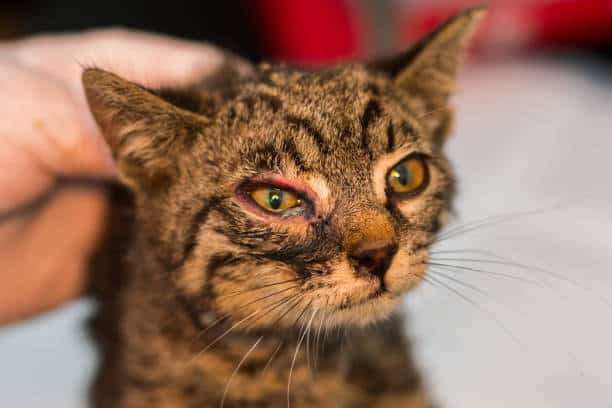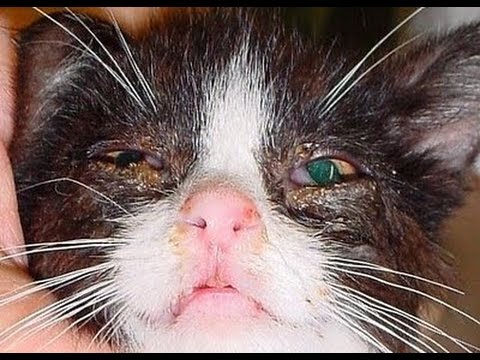To make it easy to know if your cat has an eye infection, it’s important to understand a cat’s eye anatomy. This will help you understand their condition and help you when detailing the problems to the vet. A cat’s ocular features include:
- The third eyelid: not visible under normal circumstances. It’s a thin viscous layer covering most of the outer eye.
- The cornea: a clear covering protecting the outer eye of the cat. It’s a transparent coating with 7 layers that shield its delicate organs.
- The Sclera: the whites of the eye
- The conjunctiva: the pink connective tissue attached to the eyelids and sclera.
- The uvea: this is its pigmented vascular layer which consists of the choroid, the iris, and the ciliary body.
A normal cat’s eye has:
- A tiny bit of sleep that is not excessive at the eye corner.
- Clear eyes with no swellings around the eye.
- Equal pupils
- No cloudiness or swelling
Contents
Examples Of Infections And Causes
It’s important to know the different symptoms of these infections. This will help you identify the type of infection your cat is suffering from. Some of the infections include:
Conjunctivitis

Pink eye, as it’s commonly known, can be recognized from the inflammation of the conjunctiva that covers the eyeball on the inside and the inner eyelids.
Some of the symptoms will include swelling, redness, frequent blinking, squinting, and in some cases discharge. This is caused by either a bacterial or viral infection.
Blepharitis

Blepharitis is an inflammation of the cat's eyelids. This includes the outer skin and the eyelid's middle portions including the connective tissue, the glands, and the muscle.
It’s caused by allergies, infections, tumors, congenital abnormalities, and sometimes inflammatory disorders.
Stye

Just like in humans, a stye infection happens to the sebaceous glands of a cat’s eyelid. They appear at the edge of the eyelid as a sore, red lump resembling a boil or a pimple.
Keratitis

Keratitis refers to the inflammation of the cornea. Sometimes if an infection of the eyelid is not treated, it leads to keratitis.
Symptoms include a watery or cloudy eye.
Third Eyelid Protrusion

If the third eye of your cat is visible, it tends to cross it. The infection may be from worms, a wound, diarrhea, or a viral infection.
Watery Eyes

When your cat gets watery eyes, its fur will appear matted or stained. This is because there is an overproduction of tears or the tear ducts are blocked. They are mostly caused by feline allergies or some other underlying condition.
Uveitis

Uveitis is an infection or inflammation of the uvea.
Viral infections
Feline Herpesvirus 1:
Unique to cats and in most cases causes conjunctivitis. Symptoms include an inflamed cornea, inflamed conjunctiva, eyeballs sticking to the eyelid, ulcers or soreness on the cornea, and dry eyes.
Feline Panleukopenia
Feline panleukopenia is contagious and fatal but can be vaccinated against. Mostly found in wild cats that are not vaccinated. The retina looks abnormal and the cat gets lesions in the eye. Other symptoms include vomiting, anorexia, lethargy, high fever, dehydration, and in some cases diarrhea.
Feline Infectious Peritonitis (FIP)
Feline Infectious Peritonitis is caused by coronavirus with symptoms like an inflamed inside of the eye, the cornea has fiber deposits at its back and in some cases puss. Others include inflamed lesions, inflammation of the eye, and detached retina.
Feline Leukemia Complex
Feline leukemia complex is caused by direct contact with infected felines, symptoms include lymphoma and anemia
Feline Immunodeficiency Virus (FIV)
Transmitted through bites (a cat bites another). Resembles HIV in humans. Symptoms include weakness, weight loss, chronic upper respiratory disease, chronic diarrhea, enlarged lymph nodes, stomatitis, chronic skin infections, and gingivitis.
Feline Calicivirus
Feline calicivirus occurs in cats with an upper respiratory infection and is accompanied by conjunctivitis. Symptoms include fever, rhinitis, and nasal discharge.
Those Caused By Bacteria, Protozoal, And Fungi

Chlamydiosis
It’s a bacterial infection that causes conjunctivitis. Symptoms include fever, rhinitis, Palatine, and nasal discharge.
Toxoplasmosis
A protozoal infection that causes inflammation of the eye’s inside lining.
Cryptococcosis
Caused by the environment. Eye problems brought by this include dilated eyes, peripheral blindness, detached and inflamed retinas, unresponsive pupils to light, and blindness. Other symptoms include depression, change in behavior, temperament, seizures, circling behaviors, uncoordinated movements, and dementia.
Cat-eye infection home remedy

Detecting the symptoms of an eye infection early enough will help you determine whether you need to take it to the vet or you can manage the problem from home. The following are some home remedies to help if the symptoms are mild and causes are known:
- If your cat is experiencing discharge or runny eyes, use damp cotton wool to wipe the discharge. Repeat this as many times as needed. Pat it to dry and when the cotton wool gets soiled change it. Do not use the same cotton wool for both eyes.
- If the cat or kitten eye infection has the eyelids shut due to discharge, clean them since the infection could spread to the eyelids causing blindness. To clean it, soak a ball of cotton wool in cool water (previously boiled) and repeatedly wipe it. Wipe from the inside to the outside corner while trying to pry open the eye using your other hand. Do this by applying gentle pressure to the lower and upper lids.
- Protect your cat’s eyes from irritants by keeping the face clean and trimming any long hairs near the eyelids. Avoid using aerosols near your cat due to allergies that may cause it to weep.
- Irritations can heal on their own but you can speed up the process by putting one or two milk drops in them. This clears irritations.
- Use a warm compress to relieve any pain, inflammation or irritation.
- Add 200 ml of boiled water to one tablespoon of boric acid powder. Cool it down and when slightly warm, use a syringe or eye dropper to put two drops into the eye. Clean the surrounding area with a cotton ball. Apply twice a day to clear them.
- For dry eyes, apply an eye gel.
- Use an Elizabethan collar. The collar prevents the cat from rubbing or scratching its eye during treatment.
- Keep the cat’s beddings and bowls clean.
- Offer it a well-balanced diet since most infections come from a weak immune system. The diet should contain proteins from different quality sources.
- In a home with multiple cats, monitor the others since most of the infections are contagious.
Treatment and medication

Visit a veterinarian immediately you discover an infection.
- Make sure your cat is vaccinated. This can help prevent some of these infections. Chlamydia and cat flu, for example, can be vaccinated against.
- For viral infections, its immune system will fight them off in most cases, but the vet can prescribe topical antivirals.
- For fungal infections, the vet will provide antifungal medication.
- For bacterial infections, a topical eye ointment or antibiotic drops are used.
- Apply medicine given by the vet as instructed. Most of the time application is twice per day or hourly depending on the infection.
- Do not discontinue treatment until you have given the full dosage. This protects them from antibiotic resistance.
- If the infection is serious or is caused by other underlying conditions like tumors, FIV, cancer or diseases that require surgery, the vet will advise you.
- Serious illnesses like FIV may require dehydration management using intravenous fluids and oral antibiotics to help with secondary bacterial infections.
Conclusion
Make sure your hands are clean when administering any kind of medication to the cat. Make sure that you also clean your hands after to protect yourself from getting infected. Some feline infections can be transmitted to humans.





Leave a Reply
You must be logged in to post a comment.